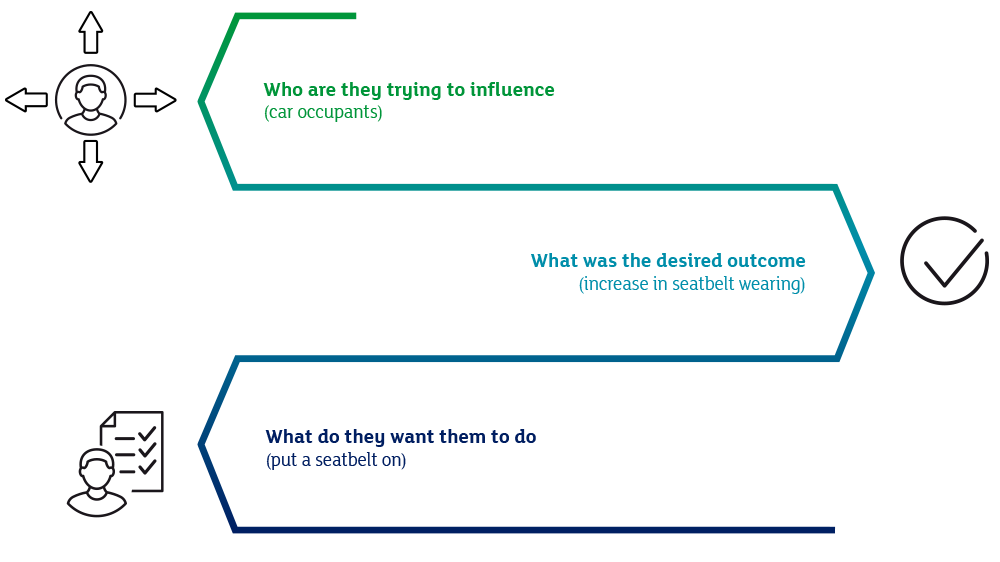
Define
It is essential when planning your intervention to set clear aims, objectives, outcomes and indicators. This shows you what you want to do with your intervention and ensures you plan what you want to measure and the changes that you want to see.
Aim
|
A brief description of why your project exists; the broad, longer-term impact you want to make; and what and who the intervention aims to change. |
Objectives (desired outcomes)
|
The activities or practival steps a project or organisation plans to carry out in order to accomplist its aims. |
Outcomes
|
The changes that the programme or intervention wants to bring about. |
Outputs
|
The products, services or facilities resulting from an organisation's activities. |
Indicator
|
A specific, observable and measurable characteristic that can be used to show changes or progress a programme is making roward achieving a specific outcome. |
Impact
|
The defined effects, both positive and negative, which the programme is expected to produce. |
Aims and objectives
The aims and objectives will describe exactly what you want your intervention to achieve and may specify what it is possible to achieve within your resource constraints.
Benefits to having clear aims and objectives:
-
Your intervention is focussed and well planned because you are forced to think of what you can realistically achieve with your resources
-
Your evaluation will be more focussed and well planned because your objectives are what you will measure when you evaluate your project.
Aims define the issue are you trying to address. The aim(s) should be clear and focus on what you expect to observe. The aim(s) should be active, not a passive voice and should define who and what you would like to change. Your aim could be to:
For example, the aim of a national seatbelt wearing campaign could be to increase seatbelt wearing amongst car occupants in the UK.
This is a good example as it states:

Objectives are more specific than aims and detail the way in which you expect to achieve the aim(s); they describe what you expect to change for those you are influencing and/or those who may benefit, by how much and by when. For example, in a seatbelt campaign the objectives could be:
-
A proportion of the target group will be able to recall the advertisement three months after the campaign
-
A higher proportion of the target group will report using seatbelts immediately after the campaign
-
A proportion of the target group will be observed wearing a seatbelt six months after the campaign.
Outcomes and indicators
Outcomes are the changes or differences that you want or expect your intervention to make.
Having clear, focused outcomes will help:
-
You work out what to measure in order to find out whether your project is making a difference, and to what extent
-
People know what they can expect to gain if they use your services
-
Funders know the impact their money will have.
Setting outcomes is vital in order to evaluate your intervention. But, don’t be tempted to set too many outcomes for your project. Usually, three to five outcomes are enough for one project.
Outcomes can be split into short-, medium- and longer-term outcomes that you expect to see and generally include change words – improve, increase, decrease or reduce.
When writing outcomes make sure you include the Who? What? And How?
- Who is changing?
- What is changing?
- How is change happening?
Indicators are what you measure to tell you what your intervention is achieving.
Indicators can be a mix of those that measure process, or what is being done in the programme, and those that measure outcomes. Each outcome could have up to four to five indicators. Indicators usually contain phases such as level of, number of, percentage of, ability to. They do not include the word ‘change’, as you will measure more than once to see change over time.
Indicator
|
Explanation
|
Process indicators
|
Track the progress of the programme. They help to answer the question - Are activities being implemented as planned?
|
Outcome indicators
|
Track how successful programme activites have been at achieving programme objectives. They help to answer the question - Have programme activites made a difference?
|
Hard
|
Quantitative - often measured in numbers
|
Soft
|
Qualitative - can be done through summaries, and interpretations
|
To measure change over time you need to think about measuring your indicators more than once. When you measure them can vary but could include:
-
A baseline – measuring the current state of an indicator often at the start of a programme
-
At various points part way through the intervention and then at the end.
-
Possibly at a late stage in the intervention, to see whether the difference you have made has diminished, maintained or increased.
Above all, make sure that your indicators are SMART.

Further reading
Definitions of outcomes and indicators
Logic models
Logic models will help you to plan and evaluate programmes by defining your intervention and visually representing the relationships among:
-
The resources you have to deliver the intervention
-
The activities you plan to deliver (outputs)
-
And the changes or results you hope to achieve (outcomes)
A logic model helps people to understand how an intervention is expected to achieve its aims and objectives. Ideally, the model is developed at the design stage of the project, but one can be created at any point.
In its simplest form, a logic model breaks the intervention down into inputs, outputs and outcomes. It is essentially a trail of how the resources (the inputs) and the delivered activities/services (the outputs) lead to the intended change (the outcomes). It is a chain of events:
Inputs
|
Activities
|
Outputs
|
Outcomes
|
|
Resources needed - what is invested and who
|
Services/What are we going to do?
|
Products that we will create
Who will participate?
|
What will we achieve? Expected benefits of the intervention
|
|
Example:
two staff
|
12 presentations delivered
|
Educational presentation to 200 people
|
Change in knowledge and attitude
|
There are two further elements to the logic model that you should also include: external factors and assumptions.
External factors:
-
These are factors outside of your control that may influence the outcome of your intervention, for example, another body may be delivering similar presentations in the same region.
-
You should also record any contextual factors that may influence the success of the intervention. For example, for a road safety intervention, external factors could include economic climate, any well-publicised incidents (crashes, high profile drink driving cases etc.), legislation/penalty changes, extreme weather conditions etc.
Intervention assumptions:
All this information will be put into a form of sequential table or flow chart. There were many examples of how to lay out a logic model or what it may look like and below is just one example, we will look at another example when we look at how to develop your logic model.
Developing your logic model
You will develop your logic model ‘out-of-sequence’ starting with your long-term outcomes and working from there. This helps to ensure that your model is connected:
…If this is done, then it is more likely that will happen…
Long-term outcome
|
Step 1: What is the long-term outcome for your intervention?
- What is it you want to achieve?
- What does success look like (for people/groups/target audience)?
- What changes do you want to see?
But ensure that:
- Can your intervention really influence the outcome in that way?
- Is this outcome important and valid?
Is outcome written so people can understand it? |
Medium term outcomes
|
Step 3:
- What behaviours or changes do you expect to see?
- What actions or practices do you expect to change?
List those behaviours, actions and changes here |
Initial/short-term outcomes
|
Step 2: Identify the initial outcomes
- What new knowledge?
- What new skills?
What do people/groups need to achieve the long-term goal? |
Outputs
|
Step 6:
As a result of those activities, what will be delivered? Outputs are important as they can often be easily monitored and tracked. Examples include:
- Attendance levels
- Number of sessions delivered
Target audience reached |
Activities
|
Step 4:
What activities do you need to conduct so that you can reach the long-term outcomes? List and identify any activities that will take place for the people to gain the knowledge and skills needed. Are the activities feasible given the resources available? |
Inputs
|
Step 5:
What inputs do you need for the activities to take place: i.e. what do you need to effectively run your intervention? |
What next?
Decide
Go back to the previous step of the evaluation process.
Develop & Collect
Click here to find out about the next step in the evaluation process